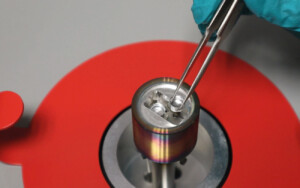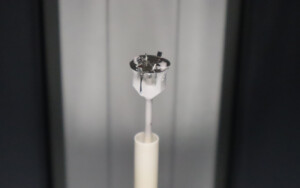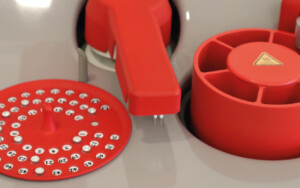An insight into Differential Scanning Calorimetry
This technique measures the temperature and heat of transformation of materials as well as their thermal capacity. It is usually referred to as DSC.

DSC – Introduction to Differential Scanning Calorimetry
DSC is a method whose principle is to measure, as a function of temperature and in comparison with an inert reference, the heat produced or absorbed during the transformation of a sample of material. During this measurement, the sample and its reference are subjected to the same fixed temperature or the same heating or cooling program.
The device that allows this measurement is commonly called a differential scanning calorimeter even if some specialists prefer the term passive diathermal calorimeter. Users simply call it “DSC”.
It is mainly composed of :
- A sensor to carry two crucibles containing : for one, the sample to be measured, and for the other, the reference material. This sensor integrates a device, usually composed of thermocouples, which continuously measures their heat flow difference.
- Sample crucibles whose material and design are chosen according to the measurements to be made. The material used is usually a metal or a ceramic, inert to the sample. They can be open, closed by a lid, completely sealed and resistant to pressures of several hundred bar, etc.
- An oven, in which the sensor, the sample and its reference are placed during the experiment. This oven is equipped with a temperature control system for heating and cooling according to a user programmed profile.
- A gas management system that monitors the composition and renewal of the atmosphere around the crucibles. Depending on the desired application, the nature of the gas(es) used can be chosen to generate an inert atmosphere, or on the contrary, a reactive one when a specific reaction of the sample needs to be studied.
Depending on their level of sophistication and performance, differential scanning calorimeters can cover the needs of research & development, quality control or teaching.
The technique can also be combined with thermogravimetric analysis in simultaneous thermal analyzers, especially when it comes to studying the decomposition of materials.
DSC and temperature measurements
When the sample is heated in the differential scanning calorimeter and undergoes a transformation, its heat flow difference with the inert reference increases, then returns to a base value after the transformation is complete. Thus, the analysis of a curve representing the difference in heat flow as a function of time or temperature allows to characterize this transformation.
So a DSC analysis can determine the temperatures of melting, crystallization, reaction, decomposition and phase change (solid-solid transformations) of materials.
There are so many applications of temperature measurement by DSC that it is impossible to list them all. However, it can be said that the technique has become a reference in the characterization of materials for energy & environment, life sciences, polymers and plastics, building materials, ceramics, glasses, metals, energy materials and chemicals.
Temperature measurements by DSC are essential to control the behavior of these materials, especially when they must be exposed to heat treatment during manufacturing, use or recycling.

DSC and heat measurements
A simple mathematical treatment (an integration) of the curve representing the difference in heat flow as a function of time allows the heat of the measured thermal effect to be determined. For this purpose, the DSC device must be calibrated beforehand using reference materials or special calibration cells.
This mathematical treatment, which can be performed easily by any user, allows the determination of the heats of melting, crystallization, reaction, decomposition and phase change (solid-solid transformations) of materials.
The heat flow difference curve also makes it possible to distinguish endothermic effects (which absorb heat: e.g. melts, transitions to a less stable phase) from exothermic effects (which release heat: e.g. crystallization, most decompositions).
DSC testing is for example important to evaluate the proportion of a component or phase in the material, or its purity, and to estimate the heat to be supplied to or removed from the material before using it in an industrial process.

DSC and heat capacity measurements
The heat capacity (Cp) characterizes both the ability of a material to absorb part of the heat it receives (the rest being transmitted) and the temperature increase it will undergo by absorbing this heat. It is therefore a fundamental data to understand, design and optimize systems where heat exchange is an important process: engines, heating systems, industrial processes, batteries, furnaces, etc.
Differential Scanning Calorimetry, through the use of a simple procedure consisting of a series of 2 to 3 measurements is able to measure the values of Cp at a temperature, or its variation over a user defined temperature range.
